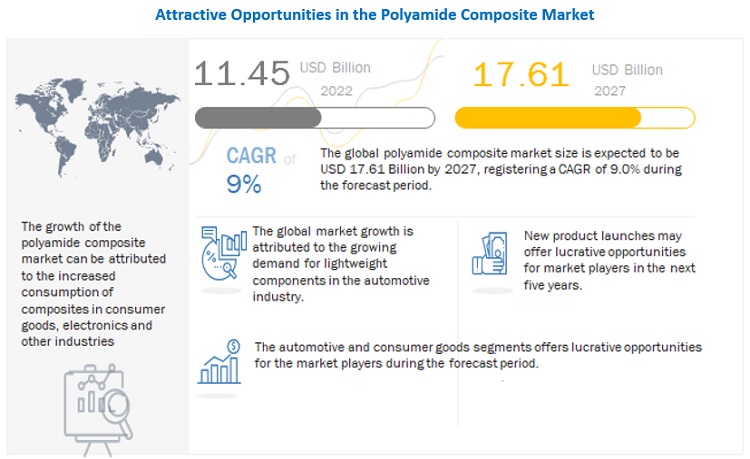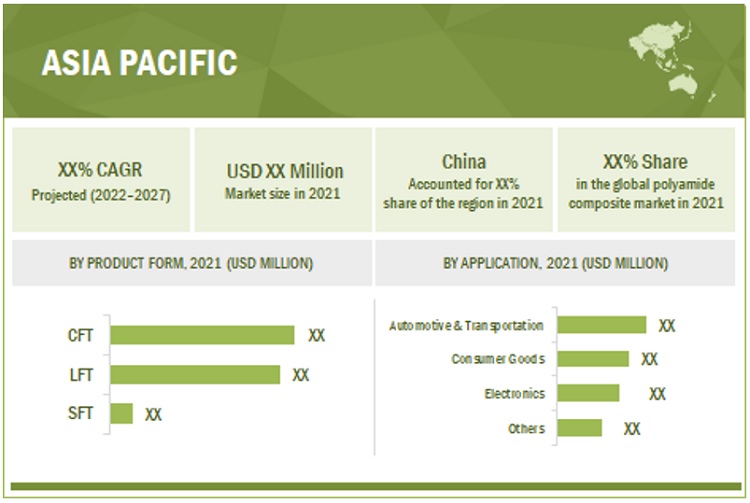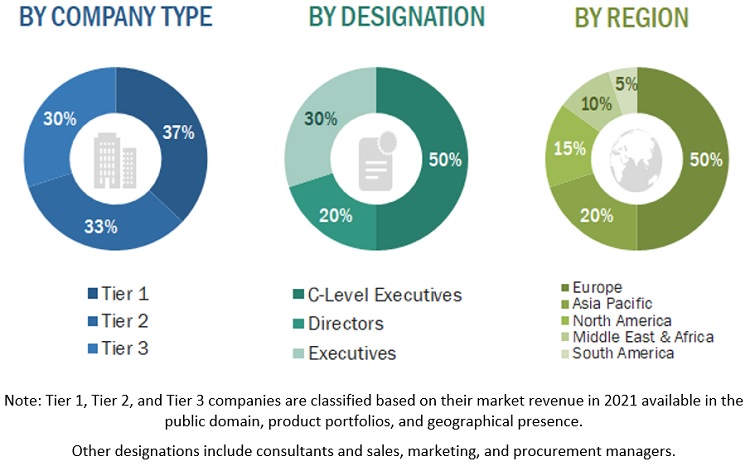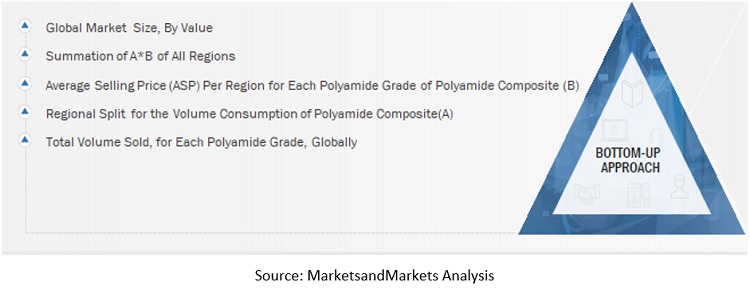Polyamide Composite Market by Polyamide Grade (PA6, PA66, PA46, PA610, PA12, Others), Product Form (SFT, LFT, CFT), Application (Automotive, Consumer Goods, Electronics, Others), Region- Forecast to 2027
The polyamide composite market is projected to reach USD 17.61 billion by 2027, at a CAGR of 9.0% from USD 11.45 billion in 2022. One of the major factors contributing to the growth of the polyamide composite market is the increased demand for lightweight automobiles. Also, the rise in electrical and electronics industry is driving the polyamide composite market.

To know about the assumptions considered for the study, Request for Free Sample Report
Market Dynamics
Driver: Increasing demand from the transportation industry to drive polyamide composites demand
Polyamide composites are used in the production of a variety of automotive components, rail coaches, and heavy vehicles. These materials are lightweight and contribute to vehicle weight reduction, which reduces CO2 emissions and improves fuel efficiency, allowing automotive manufacturers to meet CAFÉ emission standards (54.5 mpg by 2025) and other fuel norms mandated by environmental agencies. One of the driving factors driving the thermoplastic composites market in the transportation industry is the increased use of polyamide composites materials in racing and high-performance vehicle components such as the instrument panel, front end module, door modules, roof components, appearance grade components, and under-hood components.
Restraints: High raw material costs
Polyamide resins, which are used to make thermoplastic composites, are more expensive than thermoset resins. Raw materials account for a significant portion of the total cost of these composites. The raw material, processing, and manufacturing costs of thermoplastic composites are expensive, resulting in a high end-product price. This high cost is a significant impediment to OEMs in the supply chain using thermoplastic composites. Furthermore, the machinery and tools required for thermoplastic composite production are capital intensive, resulting in a high product cost. Thermoplastic composites have numerous applications in a variety of industries. However, they are not currently commercially viable. The use of thermoplastic composites in many applications is expected to be feasible if the cost of polyamide resins and the cost of thermoplastic composites are reduced.
Opportunities: Electric vehicle sales are increasing
Electric vehicles (EV) are environmentally friendly and help to reduce carbon emissions in the transportation industry. The demand for hybrid and electric vehicles is expected to skyrocket in the coming years. Polyamide composites have high strength and contribute significantly to vehicle weight reduction. As a result, they are extremely useful in the production of electric vehicle components. As a result, increased demand for electric vehicles is increasing demand for polyamide composites.
Challenges: Development of low-cost manufacturing technology
Polyamide composites have a variety of applications. However, due to their high cost, the use of these composites in many applications is not commercially viable. The production of low-cost polyamide composites has the potential to increase their consumption in a variety of end-use applications. Low-cost technology development is critical for all research organizations and resin manufacturers. However, investing in R&D to develop new technology for producing polyamide composites is a significant challenge for market participants. Nonetheless, companies are heavily investing in research and development to reduce the overall cost of polyamide composites and the end product manufactured. Some companies sell polyamide composites made from recycled polyamide compounds. Celanese Corporation (US), for example, provides ECOMID POLYAMIDE COMPOUNDS, which are made from recycled PA66 compounds. This product line provides cost-effective solutions to the automotive, consumer goods, and building industries.
“Automotive was the largest application for polyamide composite market in 2021, in terms of value”
Polyamide Composite are used in the automotive industry to make a variety of under-the-hood components such as hoses and gear shift modules. Polyamide composites are lightweight and have excellent thermal and chemical resistance, as well as dimensional stability and chemical resistance. The automotive industry requires a high strength-to-weight ratio because it determines the performance of the vehicle. This is why the industry relies on advanced materials like polyamide composites to replace metals without compromising the vehicle's strength and safety.
“Asia Pacific was the largest market for polyamide composite in 2021, in terms of value.”
Due to high demand from China, Japan, India, and other countries, Asia Pacific is the largest consumer of composite. Automotive, consumer goods, and electronics are among the major end-use industries for polyamide composites in the Asia Pacific market. Technology advancements, regulatory policies, and government norms are some of the major factors driving the Asia Pacific polyamide composite market.

To know about the assumptions considered for the study, download the pdf brochure
Key Market Players
The key players in this market BASF SE (Germany), DuPont de Nemours, Inc. (US), LANXESS AG (Germany), Royal DSM N.V. (Netherlands), and Solvay S.A. (Belgium). Continuous developments in the market—including new product launches, mergers & acquisitions, agreements, and expansions—are expected to help the market grow. Leading manufacturers of polyamide composite market have opted for new product launches to sustain their market position.

Want to explore hidden markets that can drive new revenue in Polyamide Composite Market?
 Scope of the Report
Scope of the Report

Want to explore hidden markets that can drive new revenue in Polyamide Composite Market?

|
Report Metric |
Details |
|
Years considered for the study |
2018-2027 |
|
Base Year |
2021 |
|
Forecast period |
2022–2027 |
|
Units considered |
Volume (Tons); Value (USD Billion) |
|
Segments |
Polyamide Grade, Product Form, Application, and Region |
|
Regions |
Asia Pacific, North America, Europe, Middle East & Africa, and South America |
|
Companies |
The key players in this market are BASF SE (Germany), DuPont de Nemours, Inc. (US), LANXESS AG (Germany), Royal DSM N.V. (Netherlands), Solvay S.A. (Belgium) |
This report categorizes the global polyamide composite market based on fiber type, product type, structure, application and region.
On the basis of polyamide grade, the polyamide composite market has been segmented as follows:
- PA6
- PA66
- PA46
- PA610
- PA12
- Others
On the basis of product form, the polyamide composite market has been segmented as follows:
- SFT
- LFT
- CFT
On the basis of application, the polyamide composite market has been segmented as follows:
- Automotive
- Consumer Goods
- Electronics
- Others
On the basis of region, the polyamide composite market has been segmented as follows:
- Asia Pacific
- Europe
- North America
- Middle East & Africa
- South America
Frequently Asked Questions (FAQ):
What is the expected growth rate of polyamide composite market?
The forecast period for polyamide composite market in this study is 2022-2027. The polyamide composite market is projected to grow at CAGR of 9.0%, in terms of value, during the forecast period.
Who are the major key player in polyamide composite market?
BASF SE (Germany), DuPont de Nemours, Inc. (US), LANXESS AG (Germany), Royal DSM N.V. (Netherlands), Solvay S.A. (Belgium).
Which is the largest region in the polyamide composite market?
Asia Pacific is the largest region in the polyamide composite market due to high domestic demand for polyamide composites in automotive, consumer goods, and electronics industry..
To speak to our analyst for a discussion on the above findings, click Speak to Analyst

Table of Content
1 Introduction
1.1 Objectives of the Study
1.2 Market Definition
1.3 Market Scope
1.3.1 Markets Covered
1.3.2 Years Considered in the Report
1.4 Currency
1.5 Limitations
1.6 Stakeholders
2 Research Methodology
2.1 Market Share Estimation
2.1.1 Secondary Data
2.1.1.1 Key Data from Secondary Sources
2.1.2 Primary Data
2.1.2.1 Key Data from Primary Sources
2.1.2.2 Key Industry Insights
2.2 Market Size Estimation
2.2.1 Bottom-Up Approach
2.2.2 Top-Down Approach
2.3 Market Breakdown & Data Triangulation
2.4 Research Assumptions
3 Executive Summary
4 Premium Insights
4.1 Significant Opportunities in Polyamide Composite Market, 2022–2027
4.2 Polyamide Composite Market, By Polyamide Grade
4.3 Polyamide Composite Market, By Product Form
4.4 Polyamide Composite Market, By Application
4.5 Polyamide Composite Market, By Country
5 Market Overview
5.1 Introduction
5.2 Market Segmentation
5.2.1 Polyamide Composite Market, By Polyamide Grade
5.2.2 Polyamide Composite Market, By Product Form
5.2.3 Polyamide Composite Market, By Application
5.3 Market Dynamics
5.3.1 Drivers
5.3.2 Restraints
5.3.3 Opportunities
5.4.4 Challenges
5.4 Porter's Five Forces Analysis
5.4.1 Bargaining Power of Suppliers
5.4.2 Bargaining Power of Buyers
5.4.3 Threat of New Entrants
5.4.4 Threat of Substitutes
5.4.5 Degree of Competition
5.5 Supply Chain Analysis
5.6 Ecosystem: Polyamide Composite Market
5.7 Value Chain Analysis
5.8 Technology Analysis
5.9 Pricing Analysis
5.10 Trends and Disruptions Impacting Customers
6 Polyamide Composite Market, By Polyamide Grade
6.1 PA6
6.2 PA66
6.3 PA46
6.4 PA610
6.5 PA12
6.5 Others
7 Polyamide Composite Market, By Product Form
7.1 SFT (Short Fiber Thermoplastic)
7.2 LFT (Long Fiber Thermoplastic)
7.3 CFT (Continuous Fiber Thermoplastic)
8 Polyamide Composite Market, By Application
8.1 Automotive
8.2 Consumer Goods
8.3 Electronics
8.4 Others
9 Polyamide Composite Market, By Region
9.1 Introduction
9.2 North America
9.2.1 Polyamide Composite Market Size in North America, By Application
9.2.2 Polyamide Composite Market Size in North America, By Country
9.2.2.1 Canada
9.2.2.1.1 Polyamide Composite Market Size in Canada, By Application
9.2.2.2 U.S.
9.2.2.2.1 Polyamide Composite Market Size in U.S., By Application
9.2.2.3 Mexico
9.2.2.3.1 Polyamide Composite Market Size in Mexico, By Application
9.3 Europe
9.3.1 Polyamide Composite Market Size in Europe, By Application
9.3.2 Polyamide Composite Market Size in Europe, By Country
9.3.2.1 Germany
9.3.2.1.1 Polyamide Composite Market Size in Germany, By Application
9.3.2.2 France
9.3.2.2.1 Polyamide Composite Market Size in France, By Application
9.3.2.3 UK
9.3.2.3.1 Polyamide Composite Market Size in UK, By Application
9.3.2.4 Italy
9.3.2.4.1 Polyamide Composite Market Size in Italy, By Application
9.3.2.5 Rest of Europe
9.3.2.5.1 Polyamide Composite Market Size in Rest of Europe, By Application
9.4 Asia-Pacific
9.4.1 Polyamide Composite Market Size in Asia-Pacific, By Application
9.4.2 Polyamide Composite Market Size in Asia-Pacific, By Country
9.4.2.1 China
9.4.2.1.1 Polyamide Composite Market Size in China, By Application
9.4.2.2 Japan
9.4.4.2.1 Polyamide Composite Market Size in Japan, By Application
9.4.2.3 India
9.4.2.3.1 Polyamide Composite Market Size in India, By Application
9.4.2.4 South Korea
9.4.2.4.1 Polyamide Composite Market Size in South Korea, By Application
9.4.2.5 Rest of Asia Pacific
9.4.2.5.1 Polyamide Composite Market Size in Rest of Asia Pacific, By Application
9.5 South America
9.5.1 Polyamide Composite Market Size in South America, By Application
9.5.2 Polyamide Composite Market Size in South America, By Country
9.5.2.1 Brazil
9.5.2.1.1 Polyamide Composite Market Size in Brazil, By Application
9.5.2.2 Argentina
9.5.2.2.1 Polyamide Composite Market Size in Argentina, By Application
9.5.2.3 Rest of South America
9.5.2.3.1 Polyamide Composite Market Size in South America, By Application
9.6 Middle East & Africa
9.6.1 Polyamide Composite Market Size in Middle East & Africa, By Application
9.6.2 Polyamide Composite Market Size in Middle East & Africa, By Country
9.5.2.1 Saudi Arabia
9.5.2.1.1 Polyamide Composite Market Size in Saudi Arabia, By Application
9.5.2.2 South Africa
9.5.2.2.1 Polyamide Composite Market Size in South Africa, By Application
9.5.2.3 Rest of Middle East & Africa
9.5.2.3.1 Polyamide Composite Market Size in Rest of Middle East & Africa, By Application
10 Competitive Landscape
10.1 Introduction
10.2 Market Share Analysis
10.3 Market Ranking
10.4 Market Evaluation Framework
10.4.1 Product Launches and Developments
10.4.2 Expansions
10.4.3 Contracts and Agreements
10.4.4 Mergers & Acquisitions
10.5 Revenue Analysis of Top Market Players
10.6 Company Evaluation Matrix
10.4.1 Star
10.4.2 Emerging Leaders
10.4.3 Pervasive
10.4.4 Participants
11 Company Profiles
* (Business Overview, Products Mix, Recent Developments, SWOT Analysis, MnM view)
11.1 BASF SE
11.2 DuPont de Nemours, Inc.
11.3 LANXESS AG
11.4 Royal DSM N.V.
11.5 Solvay S.A.
11.6 Arkema S.A.
11.7 Evonik Industries
11.8 SABIC
11.9 Huntsman Corporation
11.1 Mitsubishi Chemical Advanced Materials AG
11.11 Other Companies
*Details Might Not Be Captured in Case of Unlisted Companies.
Note: This is the tentative list, we will provide you the company profiles of major companies in this market.
12 Appendix
The study involved four major activities to estimate the size of polyamide composite market. Exhaustive secondary research was done to collect information on the market, the peer market, and the parent market. The next step was to validate these findings, assumptions, and sizing with industry experts across the value chain through primary research. Both top-down and bottom-up approaches were employed to estimate the complete market size. Thereafter, the market breakdown and data triangulation procedures were used to estimate the market size of the segments and subsegments.
Secondary Research
In the secondary research process, various secondary sources have been referred to for identifying and collecting information for this study. These secondary sources include annual reports, press releases, investor presentations of companies, white papers, certified publications, trade directories, certified publications, articles from recognized authors, gold standard and silver standard websites, and databases.
Secondary research has been used to obtain key information about the value chain of the industry, monetary chain of the market, the total pool of key players, market classification and segmentation according to industry trends to the bottom-most level, and regional markets. It was also used to obtain information about the key developments from a market-oriented perspective.
Primary Research
The polyamide composite market comprises several stakeholders in the value chain, which include raw material suppliers, manufacturers, distributors, and end users. Various primary sources from the supply and demand sides of the polyamide composite market have been interviewed to obtain qualitative and quantitative information.
The primary interviewees from the demand side include key opinion leaders in end-use sectors. The primary sources from the supply side include manufacturers, associations, and institutions involved in the polyamide composite industry.
The breakdown of profiles of the primary interviewees is illustrated in the figure below:

To know about the assumptions considered for the study, download the pdf brochure
Market Size Estimation
The top-down and bottom-up approaches have been used to estimate and validate the size of the polyamide composite market.
- The key players in the industry have been identified through extensive secondary research.
- The supply chain of the industry has been determined through primary and secondary research.
- All percentage shares, splits, and breakdowns have been determined using secondary sources and verified through primary sources.
- All possible parameters that affect the markets covered in this research study have been accounted for, viewed in extensive detail, verified through primary research, and analyzed to obtain the final quantitative and qualitative data.
- The research includes the study of reports, reviews, and newsletters of the key market players, along with extensive interviews for opinions with leaders such as directors and marketing executives.
Polyamide Composite Market: Bottom-Up Approach 1

To know about the assumptions considered for the study, Request for Free Sample Report
Data Triangulation
After arriving at the total market size from the estimation process explained above, the overall market has been split into several segments and sub-segments. To complete the overall market engineering process and arrive at the exact statistics for all the segments and sub-segments, the data triangulation and market breakdown procedures have been employed, wherever applicable. The data has been triangulated by studying various factors and trends from both the demand and supply sides. Along with this, the market size has been validated by using both the top-down and bottom-up approaches and primary interviews. Hence, for every data segment, there have been three sources—top-down approach, bottom-up approach, and expert interviews. The data was assumed correct when the values arrived from the three sources matched.
Report Objectives
- To define, describe, and forecast the size of the polyamide composite market, in terms of value and volume
- To provide detailed information regarding the major factors (drivers, opportunities, restraints, and challenges) influencing the growth of the market
- To estimate and forecast the market size based on polyamide grade, product form, application, and region
- To forecast the size of the market with respect to major regions, namely, Europe, North America, Asia Pacific, and Middle East & Africa, and South America along with their key countries
- To strategically analyze micromarkets with respect to individual growth trends, prospects, and their contribution to the overall market
- To analyze opportunities in the market for stakeholders and provide a competitive landscape of market leaders
- To track and analyze recent developments such as expansions, new product launches, partnerships & agreements, and acquisitions in the market
- To strategically profile key market players and comprehensively analyze their core competencies
Available Customizations
Along with the given market data, MarketsandMarkets offers customizations according to the company’s specific needs. The following customization options are available for the report:
Regional Analysis
Further breakdown of a region with respect to a particular country or additional application
Company Information
Detailed analysis and profiles of additional market players














Growth opportunities and latent adjacency in Polyamide Composite Market